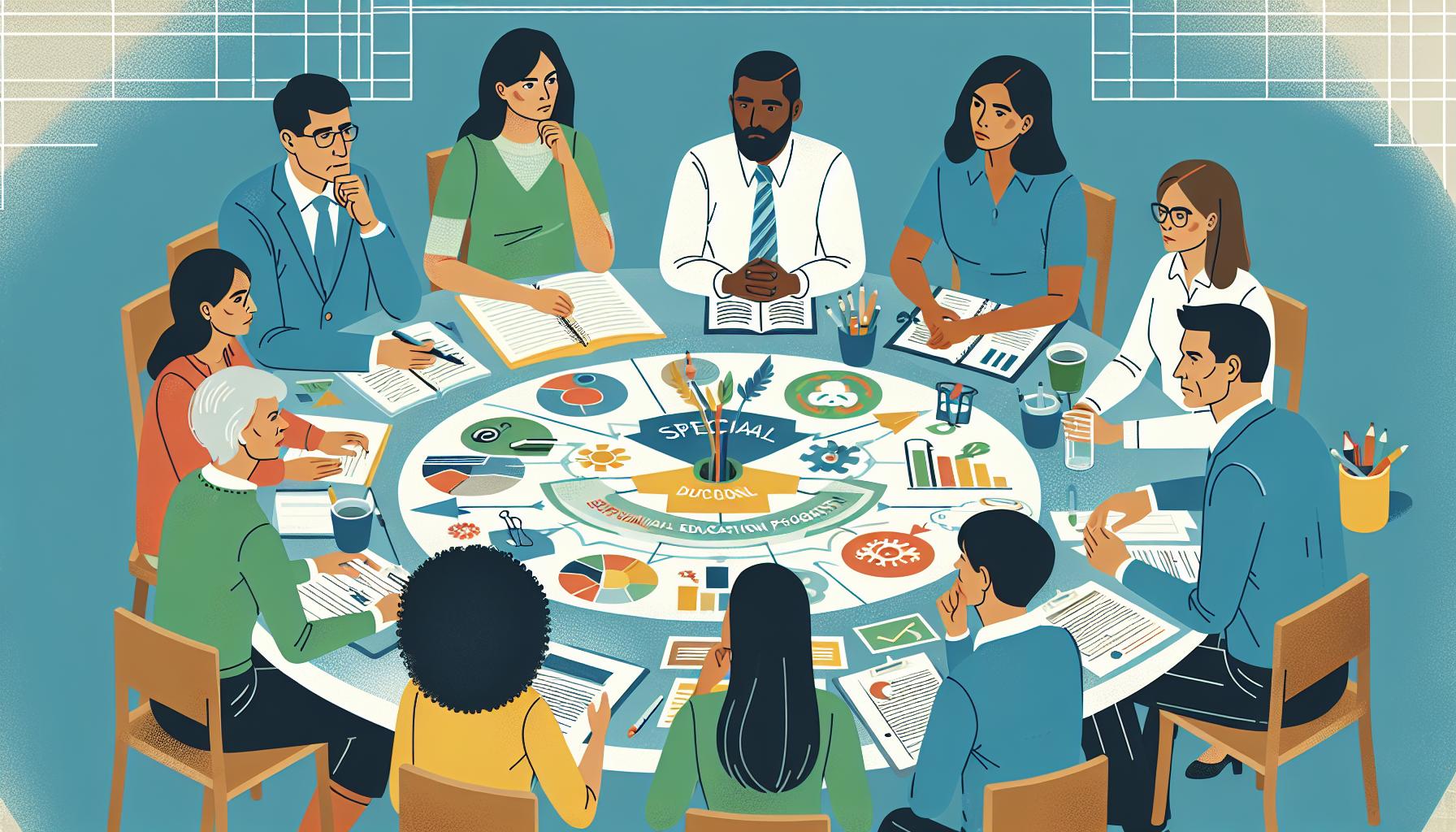Understanding IEP Meetings: A Guide for Parents to Navigate Their Child’s Education
Ever found yourself wondering what an IEP meeting is? You’re not alone. It’s a common question among parents, especially those with children who have special education needs. An IEP, or Individualized Education Program, is a legal document that outlines a child’s unique learning needs and the specific services a school will provide to meet those needs.
IEP meetings are where all this magic happens. They’re a critical part of ensuring your child gets the education they deserve. In these meetings, you’ll sit down with a team of education professionals to discuss and plan your child’s educational path. It’s a chance for you to voice your concerns, ask questions, and collaborate on your child’s learning journey. So, let’s dive in and explore what an IEP meeting entails.
Key Takeaways
- An Individualized Education Program (IEP) is a legal document that outlines a child’s unique learning needs and the specific services a school will provide to fulfill those needs.
- IEP meetings are crucial for developing and adjusting educational strategies based on the unique needs of the child. They are team efforts involving parents, special education teachers, district representatives, and the child themselves when appropriate.
- IEP meetings serve as a continuous feedback loop, allowing necessary adjustments to the IEP to be made promptly to stay effective and relevant.
- The participants in an IEP meeting all contribute their unique perspective and expertise to develop an accessible and comprehensive educational plan for the child.
- Preparation for an IEP meeting includes reviewing the current IEP, gathering feedback from your child and their teachers, and researching potential strategies or accommodations.
- For successful IEP meetings, it is beneficial to understand the child’s current situation, identify key issues, and bring along necessary documents and questions. This ensures active participation and guides constructive discussions to reach the best outcomes for the child.
Understanding IEP Meetings

Picture this: You walk into a room filled with school district staff – teachers, administrators, and special education service providers. You’re starting your child’s IEP meeting. This meeting is where everyone will come together to discuss and decide the best course of action for your child’s educational needs. Surely, it can be an overwhelming experience considering the gravity of these discussions, especially if it’s your first time. But don’t fret! It’s crucial to remember, this is your opportunity, as a parent, to have a say in your child’s education.
An IEP meeting usually follows a conventional pattern. Beginning with the current performance of your child, moving to the changes needed in the educational plan, and finally settling on the strategies to implement the plan. It’s a cycle of continuous improvement and adjustment to secure the best possible outcomes for your child.
Recognize that these meetings are team efforts. The team typically includes you (the parents), special education teachers, district representatives, and often the child themselves when appropriate. The input of each person is vital in setting the learning targets and devising the strategies.
At the end of the day, the focus of IEP meetings is to decide how your child will receive an education that’s tailored to their individual needs – because every child has the right to an education that helps them reach their full potential.
In the following sections, we’ll delve deeper into the participants, structure, and different types of IEP meetings. So sit tight and stay tuned as we demystify the IEP process for you.
Importance of IEP Meetings

Diving deeper into the world of IEP meetings, you’ll realize these are not just institutional requirements – they’re pivotal moments in your child’s educational journey. IEP meetings are akin to tailored blueprints for your child’s education, crafted with utmost care to suit individual learning needs.
One of the most significant aspects of an IEP meeting is its proactive and symbiotic approach. It’s here where concerns are voiced, challenges are acknowledged, and victories are celebrated. Borrowing from the expertise of each team member, solutions are discussed, goals are set, and learning strategies are devised. This collaborative nature of IEP meetings fosters an environment of understanding and mutual respect.
Moreover, these meetings enable regular monitoring of the child’s educational progress. Regular assessments indicate where the child excels, struggles, or needs a new approach. It’s a check and balance system ensuring the child’s education aligns with their Individualized Education Plan.
Fundamentally, IEP meetings serve as a continuous feedback loop. They allow for necessary plan adjustments to be made promptly, ensuring the strategies stay relevant and effective. The team can swiftly tackle any emerging issues or changes in your child’s circumstances. This continuous revision and readjustment of the IEP underpin the child’s progression and success.
We mustn’t overlook the critical role of these meetings in parental involvement. You’re not just a bystander – you’re a key player. It’s your opportunity to voice your opinions, concerns, and your aspirations for your child. Your input is invaluable in creating a comprehensive plan suited to your child’s unique needs and strengths.
In the following sections, we’ll delve into the different types of IEP meetings, the potential participants, and further unravel the structure of these game-changing encounters. Stay tuned.
Participants in an IEP Meeting

Prepare yourself to dive headfirst into the most captivating part of an IEP meeting – the participants! Isn’t it intriguing to know that an IEP meeting isn’t a one-dimensional gathering? Instead, it’s a collaborative platform energized by the professional insights and personal commitment of various people who each play a part in your child’s education.
Chief among the IEP meeting participants is you, the parent. Your perspectives, experiences, and all the knowledge you’ve gathered about your child’s needs while interacting, learning, and growing with them, make you a pivotal influencer in the meeting. You’ll have a vital role in drafting the IEP, setting up educational goals, and implementing strategies most effective for your child’s learning journey.
Next, we’ve got the general education teacher. This professional brings their expertise in curriculum and insight into your child’s performance in the classroom. They’d be actively involved in shaping the academic objectives for your child, discussing adjustments needed in the classroom or curriculum to ensure accessibility, and monitoring the implementation of the strategies agreed upon in the IEP.
Every IEP huddle also includes a representative from the school district, known as an LEA (Local Education Agency). The LEA representative’s job is to make sure the resources needed for the implementation of the IEP are available. They possess a keen understanding of the district’s guidelines and policies and are authorized to make commitments on behalf of the school district.
These meetings won’t omit the crucial input of a special education teacher, who is an expert in addressing the individualized needs of children with disabilities. Their role in the meeting is to share their expertise in adjusting teaching strategies, materials, and learning environment to meet your child’s specific needs.
To spruce things up, there might be additional members on board based on the individual needs of your child. For instance, therapists, psychologists, counselors, or other specialists could join the team, each bringing their unique expertise to the table.
In a nutshell, an IEP meeting’s cast of characters ensures that your child’s educational plan is comprehensive, accessible and pitched perfectly to their capabilities.
Planning and Preparation for an IEP Meeting
Running into an IEP meeting without proper preparation might dampen the experience. Your involvement as a parent is pivotal in these meetings, so here are some steps to help you make the most of it.
Starting with your child’s current IEP, review it thoroughly. What are the identified goals? How far has your child progressed towards them? These are important questions to help you measure success and determine potential areas of interest or concern that you’d like to discuss.
Next, solicit feedback from your child. Their first-hand experiences and feelings are crucial bits of information that can shape the IEP. When possible, involve the child in the planning process. This ensures their needs and preferences are reflected in the discussion.
Also, don’t forget about the teachers and specialists who work with your child. Seek their perspectives on your child’s progress and needs. They’re closely involved with the academic side of things, and likely can offer insights that can assist in building a more robust IEP.
In preparing for an IEP meeting, you might find it helpful to:
- Understand your child’s current academic and developmental status.
- Identify key issues or concerns to address.
- Research possible strategies or accommodations to propose.
- Prepare notes and documents to reference during the meeting.
Tips for Successful IEP Meetings
In the realm of Individual Education Programs (IEPs), effective planning equates to half the battle won. To make the most of your child’s IEP meetings, incorporate these practical strategies into your preparation process.
First off, it’s crucial to start with a thorough review of your child’s current IEP. Knowing where you are helps you establish where you need to go. Don’t just glance through it, but also take time to comprehend the goals, accommodations, and services mentioned. Trust us, this little homework goes a long way in easing the meeting anxiety.
As parents, you’re naturally attuned to your child’s needs. However, it’s essential to directly seek their feedback. After all, they are the ones at the coalface. What challenges do they face? What type of support would they appreciate? The answers to these questions provide unique insights that only your child can offer.
You might wonder – how does one prepare for an IEP meeting per se? To get started you need a list of items to bring along with your questions. With this, you’re not only making sure you’re ready but also ensuring you get the most out of the meeting. Here are a few must-haves for your IEP meeting checklist:
- The most recent school report
- Notes from your child about their school experience
- List of questions to ask
- Information from teachers or specialists
Ensuring you have the necessary data at hand allows you to streamline the IEP process and focus on constructive discussions. An informed parent is an empowered parent and this certainly rings true in the context of IEP meetings.
Remember, it’s not just about raising concerns or asking questions. A successful IEP meeting has proactive solution identification as its hallmark. So, while preparing for the meeting, dedicate some time to research strategies that address your child’s specific needs. There’s plenty of information online – forums, articles, education portals. Find out what has worked for other parents in similar circumstances. This way, you’re not just addressing problems but also bringing viable solutions to the table.
Adopting these approaches can enable you to be an active participant in shaping your child’s educational future. After all, no one knows your child better than you.
Conclusion
So, you’ve now got the lowdown on what an IEP meeting is all about. Remember, your role as a parent is pivotal in these meetings. With proper preparation and active involvement, you can help shape your child’s educational journey. Start with a comprehensive review of the existing IEP, engage your child for feedback, and come prepared with a checklist of essentials. Don’t shy away from researching strategies that could address your child’s unique needs. The more informed and proactive you are, the more effective your contributions will be. IEP meetings are more than just a formality – they’re your chance to make a difference in your child’s academic success.
Frequently Asked Questions
What does the article suggest for successful IEP meetings?
The article suggests thorough preparation for successful IEP meetings, which includes reviewing the current IEP, seeking feedback from the child directly, and preparing essential items like school reports and teacher’s information.
How can parents be involved in the IEP meetings?
Parents play a crucial role in their child’s IEP meetings by being well-informed and actively participating. They can contribute to shaping the child’s educational future through proactive solution identification that meets their child’s specific needs.
Why is it important to review the current IEP?
Reviewing the current IEP is essential as it provides a reference point to understand the child’s progress and areas that need more attention and improvement.
What is the role of a checklist in an IEP meeting?
A checklist helps to organize essential items such as school reports, child’s notes, questions, and teacher’s information needed for the IEP meeting, ensuring nothing crucial is missed.
What is proactive solution identification?
Proactive solution identification involves researching and understanding strategies that address the child’s specific needs before the IEP meeting. Such an approach enables parents to contribute significantly to their child’s IEP meetings.
The post Understanding IEP Meetings: A Guide for Parents to Navigate Their Child’s Education appeared first on Special Education Journey.
Understanding IEP Meetings: A Guide for Parents to Navigate Their Child’s Education published first on https://special-education-journey.com/
Comments
Post a Comment